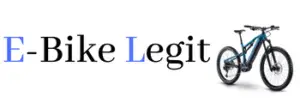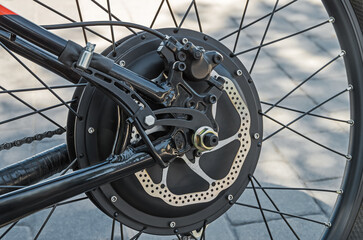A hydraulic pump is a mechanical device that uses fluid power to transfer energy from one location to another. It works by using a motor or other power source to drive a piston, which in turn pushes fluid through a pipe or hose. The fluid then flows into a cylinder or other device, where it exerts force to perform work.
The purpose of using a hydraulic pump on an electric bike is to provide additional power to the bike’s braking system. Electric bikes often rely on traditional cable-actuated brakes, which can be less efficient than hydraulic brakes. By using a hydraulic pump, the rider can apply more force to the brakes, resulting in faster and more efficient stopping power. Additionally, hydraulic brakes offer better modulation, which allows the rider to have more control over the bike’s speed while braking.
In short, a hydraulic pump converts the energy of the rider into force that can be used to stop the bike more efficiently. This is particularly useful when the bike is going at high speeds and the rider needs to make quick stops. Additionally, the use of a hydraulic pump can also provide more control over the bike while braking, which can improve the overall safety of the ride.
Choosing the Right Hydraulic Pump
When it comes to selecting a hydraulic pump for your electric bike, there are a few key factors to consider. These include size, pressure, and compatibility with your bike’s braking system.
- Size: The size of the pump is an important consideration, as it will determine how much fluid can be moved at one time. In general, larger pumps will be able to generate more pressure and provide more stopping power, but they may also be bulkier and heavier.
- Pressure: The pressure rating of the pump is another important factor to consider. This will determine how much force can be generated by the pump and will depend on the type of brakes on your electric bike. It’s important to choose a pump with a pressure rating that is compatible with your bike’s braking system.
- Compatibility: Before purchasing a pump, it’s important to make sure it is compatible with your electric bike’s braking system. Some pumps may only work with certain types of brakes, so it’s important to check the manufacturer’s specifications to ensure compatibility.
With these factors in mind, here are a few recommended pumps for electric bikes:
- Shimano Deore XT: This pump is known for its high-quality construction and smooth operation. It is compatible with most brake systems and offers a pressure rating of up to 50 bar.
- Magura MT5e: This pump is designed specifically for electric bikes and offers a pressure rating of up to 35 bar. It also features a user-friendly design and an easy-to-use lever.
- SRAM Guide RSC: This pump is known for its durability and offers a pressure rating of up to 55 bar. It is compatible with most brake systems and features a tool-free reach adjustment.
Ultimately, the best hydraulic pump for your electric bike will depend on your specific needs and preferences. By considering factors such as size, pressure, and compatibility, you can ensure that you choose a pump that will provide optimal performance for your bike.
Installing the Hydraulic Pump
Before you begin installing your hydraulic pump, it is important to gather all of the necessary tools and materials. The specific items you will need will depend on the type of pump you are using and the current setup of your electric bike. However, some general items that you may need include:
- A wrench or pliers for tightening bolts and fittings
- A bleed kit for removing air from the brake lines
- Replacement brake fluid
- A torque wrench for ensuring proper tightening of bolts
Step-by-step instructions for installing the pump:
- Begin by removing the existing brake system from your electric bike. This will typically involve removing the brake levers, calipers, and any other components that are connected to the brake lines.
- Next, install the new brake lines and fittings that will connect the pump to the calipers. Be sure to use the proper fittings and torque them to the manufacturer’s specifications.
- Mount the pump to the bike frame, using the appropriate hardware. This may involve drilling new holes or using existing ones.
- Connect the brake lines to the pump and calipers, making sure that they are properly aligned and tightened.
- Use the bleed kit to remove any air that may be trapped in the brake lines. This is an important step to ensure proper braking performance.
- Finally, test the brakes to ensure they are working properly. Make any necessary adjustments and add brake fluid as needed.
Tips for successful installation:
- Always refer to the manufacturer’s instructions for specific details on installation and compatibility.
- Make sure to use the appropriate fittings and torque values when installing the brake lines and fittings.
- Be sure to bleed the brake lines thoroughly to remove any air that may be trapped inside.
- Test the brakes thoroughly after installation to ensure they are working properly.
- Remember to keep the bike in a level position while doing the installation to avoid any air bubbles.
- Take your time and don’t rush the process, a proper installation will save you from future maintenance and troubles.
Using the Hydraulic Pump
Once the hydraulic pump has been installed on your electric bike, it’s time to start using it! But before you hit the road, it’s important to understand how the pump works in conjunction with the rest of the bike.
The hydraulic pump is connected to the brake system of the bike and is powered by the electric motor. When the rider applies the brakes, the pump sends pressurized fluid through the brake lines to the calipers. The calipers then use this pressure to clamp down on the brake pads, slowing down the rotation of the wheels and bringing the bike to a stop.
To operate the pump effectively, it’s important to make sure the pressure is set correctly. This can usually be done by adjusting a knob or lever on the pump itself. It’s also important to bleed any air from the system, as air bubbles can reduce the effectiveness of the brakes. This can be done by using a bleed kit, which is available from most bike shops.
Regular maintenance is important to keep the pump in good working order. This includes checking the fluid level and replacing it if necessary, as well as inspecting the brake pads for wear and replacing them as needed. It’s also a good idea to keep the pump clean and free of debris.
If you experience any problems with the pump, the first step is to check the fluid level and make sure it’s at the correct level. If the problem persists, it may be necessary to take the bike to a professional mechanic for further troubleshooting. Common issues include leaks in the brake lines, a worn-out pump, or a malfunctioning brake caliper.
In conclusion, the use of a hydraulic pump on an electric bike can provide better stopping power and control while riding. It’s important to understand how the pump works and how to operate it effectively, as well as to keep up with regular maintenance. By doing so, you will ensure that the pump will function properly and improve the overall safety of your ride.
FAQs
How do you adjust hydraulic brakes on an e-bike?
To adjust the brake tension on an e-bike with hydraulic brakes, first, make sure the bike is in a stable position and the wheels are not turning. Then, locate the adjustment knob or lever on the brake lever, which is usually located on the top or near the top of the lever. To increase the brake tension, turn the knob or lever clockwise and to decrease the tension, turn it counterclockwise. Test the brakes by squeezing the lever and making sure they are not too loose or too tight. It is important to consult the manufacturer’s manual for specific instructions.
How do I increase my e-bike acceleration?
To increase the acceleration of your e-bike, ensure that your bike is properly maintained and in good working condition. Check the tire pressure and make sure they are at the recommended levels. Adjust the pedal assist level on your bike, which can usually be done by using a button or twisting grip on the handlebar. Consider upgrading to a more powerful electric motor. And check and adjust the chain tension and make sure it is lubricated.
How do I adjust the tension on my hydraulic brakes?
To adjust the tension on your hydraulic brakes, first, make sure the bike is in a stable position and the wheels are not turning. Then, locate the adjustment knob or lever on the brake lever, which is usually located on the top or near the top of the lever. To increase the brake tension, turn the knob or lever clockwise and to decrease the tension, turn it counterclockwise. Test the brakes by squeezing the lever and making sure they are not too loose or too tight. It is important to consult the manufacturer’s manual for specific instructions.

